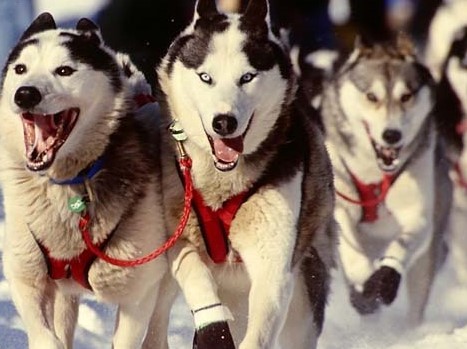Man, Dog & Sled- Toughest Race On Earth
With some 1,000 miles of frozen landscape to conquer, Alaska’s annual Iditarod Trail Sled Dog Race is no ice-cream picnic.
Few sporting events claim extreme weather as a fundamental racing challenge. For 8-15 days or more, humans and canine contend with nature’s arctic fury. Blinding blizzards are common and gale force gusts can send wind chill temperatures to -100 F (-73 C).
Mushers are known to experience hallucinations induced by dehydration and sleep deprivation.
Kicking off in Anchorage, ending in Nome and depending on the year’s route, mushers work their dogs around the clock through roughly 20 checkpoints across open tundra and spruce forests.
By rule, rest is mandatory only three times, one 24 hour layover at a checkpoint of choice and two 8 hour stops at other predetermined locations.
Sled drivers start off with 12-16 of the preferred husky breeds but must finish the race with at least 5 in tow. Dogs are dropped off at checkpoints if they fatigue or become injured.
Over the years, a number of these ultramarathoners died on the trail, including from attacks by moose.
The self-proclaimed “Last Great Race” took off in 1973 as homage to Alaska’s indigenous heritage and mode of winter transport.
Dog teams delivered mail and supplies in the 19th century to remote mining towns on a main trail named after a river post- Haiditarod- or “distant place” in the Ingalik tongue.
The advent of the plane in the 1920’s and snowmobile in the 1960’s essentially killed the sled as a work vehicle.
Popular in northern countries, dog sledding had its shot at the Winter Olympics in Lake Placid (1932) and in Oslo (1952) but failed to pick up traction. It remained a demonstration sport and never gained official event status.
But the popularity of the Iditarod launched interest in the canine snow pursuit and some of the races today read like NASCAR on ice: the Kobuk 440, the Kusko 300, the Klondike 300, and the Copper Basin 300.
In 2016, with his lead dogs Reef and Tide, Alaskan Dallas Seavey recorded the fastest ever Iditarod race time in 8 days 11:20:16. In comparison, the inaugural chase in 1973 was won in no less than 20 days.
The sponsorship purse is relatively low compared to mainstream professional sports. That year, Seavey took home $75,000 in cash winnings and a new pickup truck.
But at the finish line, the true champions are the four-legged athletes. Despite their specialty breed, these heroes brave life trudging and lugging at 5-12 mph across America’s biggest state.
Try accomplishing that feat on two legs.










